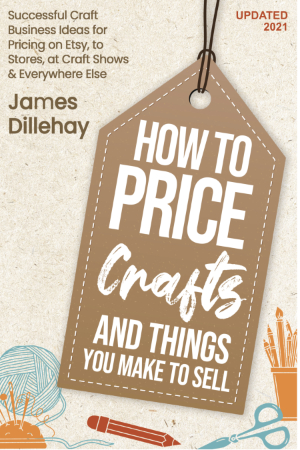Perceived value is the worth a shopper places on an item when considering a purchase. Makers almost always start out under-pricing their craft products thinking they will attract more buyers.
But in the handmade marketplace, lowering the price more often lowers the perceived value. The misconception is that price determines sales, which is mostly untrue in the handmade products marketplace.
What is true more often is that sales are driven by what you do to market, display, package, and a host of other promotional actions. You have immense power to affect the value, and therefore the price, shoppers assign to your products.
Here are a few ways to up the perception of value of your handmade crafts for sale.
Position your handmade products in front of affluent buyers
The price range of your items has to appeal to shoppers in the market you are selling. If you sell items below $20, your market differs from someone selling items at $100 and up.
When your product line isn’t selling at a specific price point, it may not be the products but that you have positioned them in front of the wrong audience. I have made products that didn’t sell at craft shows but flew out the door of my wholesale accounts.
When I first opened my gallery, I had more wall space than inventory to display. To fill the empty space, I took the pieces I would have priced at $150 at a crafts show and marked prices up to $250 and mounted them on the gallery walls, shining a track light on them for illumination. I didn’t expect them to sell at the new price, I just needed to make it look like we had plenty of inventory. They sold so fast, I had to hustle to make more.
Raise the price, then offer a discount
For my most popular product line, I was having the problem of keeping up with sales. So I raised the price of a $30 scarf to $34. At the same time, I changed the way I answered shoppers at shows when they asked the price (already posted clearly on several signs on my booth, oh well.) “Buy one scarf for $34, or if you need gifts for someone, get more than one for $30 each.”
My repeat customers did not complain about the new price. Some continued to buy only one at the $34 price. My average transaction size increased as did my profit margin per piece.
Offer personalization
Does your item lend itself to personalization? Can you engrave, embroider, paint, burn, stamp, or in other ways add the customer’s requested name to their order? The average volume of product searches containing the word “personalized” on Etsy is around 40,000 per month.
If so, you can raise your price for this service. Customers expect to pay more to have a personalized gift they can give to someone special.
When setting up a product listing, Etsy lets sellers add the option for customers to personalize their purchase for an extra fee. If you offer a generic version of the product, create a separate listing at a higher price for personalization.
If you can offer this option to shoppers, include the word “personalized” in your listing title and tags to help your page show up in more searches.
Tell them it’s handmade
In your marketing messages, packaging, and displays highlight the fact that your product is made by hand. Unless you tell shoppers, they may not realize this.
You really want to tap into the buy handmade movement. Studies have shown consumers are willing to pay more for products made by hand.
Be Earth-friendly
If you use environmentally friendly materials, use words in your product signage and descriptions to remind shoppers that your products are eco-friendly, sustainable, green or from recycled materials (of course, only if any of these are true.) For example, you might make dinosaur sculptures from recycled tin thrown out from construction sites. Or you might use lead-free solder or paints.
Consumers are on the lookout for the environmental impact of the materials in the products they buy. Shoppers are willing to pay more to go green. Just look at the success of Whole Foods, for example.
Display a higher priced option next to a lower priced option
Studies show that displaying a premium option next to a less costly option, cues the brain differently than offering only one choice. It’s call price anchoring.
Between two differently priced options, the lower priced item suddenly looks like a deal, even if you have raised its price recently.
Anchoring works the other way, too. Some shoppers, seeing the lower priced product, choose the premium offer, because they want the best.
Just ask
Makers often feel timid about raising prices. The fear is people won’t buy it at a higher price. More often than not, you may sell as much or more. All you have to do is ask and see what happens.
I taught a friend how to weave. She started weaving scarves similar to ones I sold wholesale to a gallery which retailed them for $95; paying me $57. After material costs, I earned around $25 an hour.
To help her get going in her business, I introduced her to the gallery owners. She asked them to retail her scarves at $150. They agreed. And the scarves sold just as well at that price as mine had for $95. And yes, I increased my prices after this.
The point is if you don’t ask, you will never know.
The above are seven of the twenty-four ways to raise your prices without raising eyebrows excerpted from How to Price Crafts and Things You Make to Sell by James Dillehay.
Related article: pricing crafts.
Also see: Formula for profit calculation and Pricing Calculator

